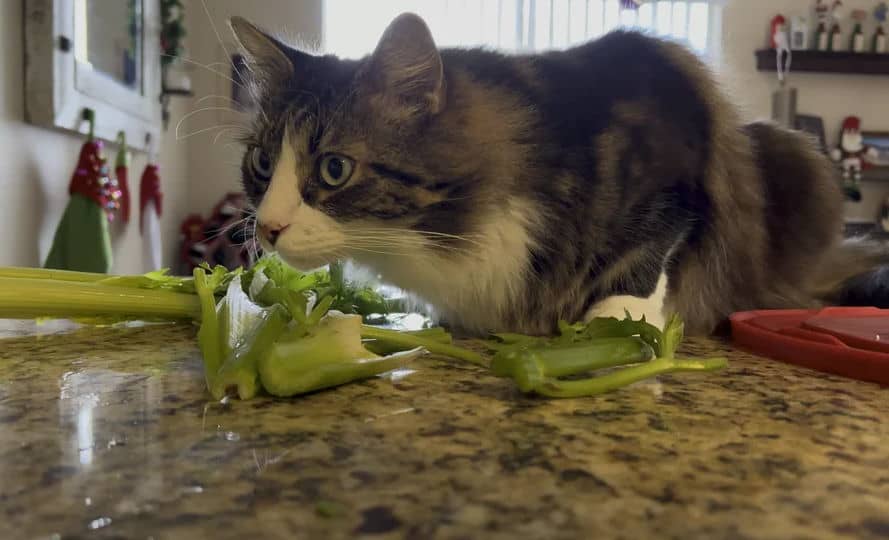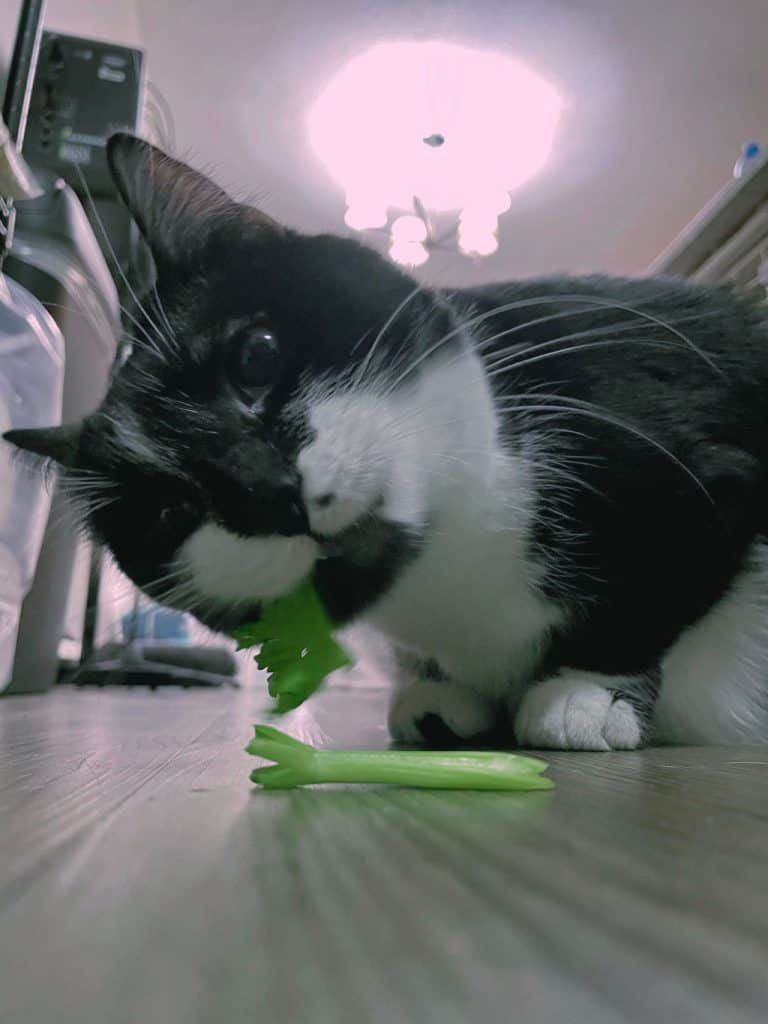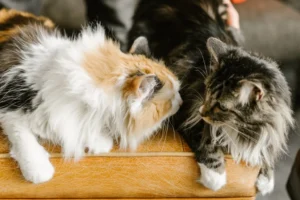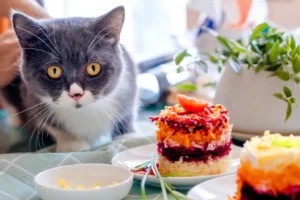I’ve got a cat that’s obsessed with celery. My friend’s cat also likes it. So I wondered what makes celery so special that so many cats would act crazy about it.
Cats may be attracted to celery due to its compounds that mimic the pheromones or odors that cats find appealing, or simply because of its texture and taste. This attraction may be due to cats’ instinct to respond to chemical signals and enjoy chewing on plant materials.
In addition, the scents in celery are quite potent, and cats are especially sensitive to smells. There’s also Sedanenolide, which may play a part. All of this can make a cat become obsessive about celery.

What Is It About Celery That Attracts Cats?
Celery has a strong scent, and the leaves can have the same effect as catnip. It smells and tastes spicy and is used to flavor spicy and vegetable soups.
Celery leaves can cause your cat to act goofy, roll about, rub, and vocalize as though it were catnip.
My cat would grab a piece and begin licking it as I cut it. Then, he may also get high, like with the catnip. He would defend his tiny bit of celery with his teeth and claws if I tried to take it away.
One possible explanation for why cats may be attracted to plants like celery is that these plants contain compounds that mimic pheromones or other odors that cats find appealing.
For example, some plants contain compounds that are similar to the pheromones produced by cats during mating, marking territory, or other social behaviors. Cats may be drawn to these scents out of instinct, as they have evolved to be highly attuned to the chemical signals in their environment.
It’s also possible that cats are simply attracted to the texture or taste of certain plant materials. Some cats may enjoy the sensation of chewing on crunchy leaves or stems, or they may find the flavor of certain plants appealing.
Could Sedanolide or Sedanenolide be responsible?
Sedanenolide is the naturally occurring lactone in celery, a major contributor to its flavor, and may be one of the reasons cats are attracted to this vegetable.
Sedanenolide is a naturally occurring substance found in delicious umbelliferous plants like parsley, celery, and carrots. There’s a lot of it in celery seed oil, though there’s limited research on whether it occurs in celery leaves as well.
Similarly, Sedanolide is found in some plants in the Apiaceae family, including celery. It has been studied for its potential health benefits and has been reported to have anti-inflammatory and antioxidant properties.
However, there is no clear evidence of whether Sedanenolide has a direct effect on cats.
While Sedanenolide is present in celery and may intrigue cats, vegetables like fennel and coriander from the Apiaceae family also contain similar compounds. It’d be an interesting experiment for cat owners to see if their feline friends are equally curious about these.
The bottom line is that there is no clear consensus on what specifically attracts cats to celery or other plants. Some people believe that the smell or taste of certain plant compounds, such as sedanolide or sedanenolide, may be appealing to cats, but there is limited research on this topic.
Is Celery Safe for Cats?
Cooked celery leaves are generally harmless for cats. Foods high in fiber may help with diabetes, diarrhea, and constipation, but only if given in smaller amounts. If your cats consume too much of it, they can get sick.
Fresh celery is also fine. My cat is completely crazy with fresh celery, so I asked my vet if it was safe, and he said it was OK and nothing to be concerned about. So whenever we cut celery, we give him a piece to play with.
Cats are prone to urinary crystals, and celery supports kidney health. In other words, celery causes your cat to urinate naturally and may act as a natural diuretic.
While celery can offer hydration due to its high water content, it’s no substitute for fresh drinking water. Ensure your cat always has access to clean water, especially when they’re nibbling on plant-based treats.

Should Cats Eat Celery Regularly?
Although cats can eat celery just fine, try not to give them too much of it. For a cat, celery cannot take the place of a healthy diet. Owners should not view celery as a staple in a cat’s diet but rather as an extra treat or sporadic inclusion.
Celery contains a lot of fiber. However, since cats are obligate Carnivores, they don’t require too much fiber. Additional fiber is given to cats with diarrhea, constipation, diabetes, high blood fat levels, or stomach upsets.
Though high fiber content can be advantageous, it can be difficult to digest. Celery and other allergies may also react differently. It’s important to know what to feed your cat, especially a young kitten.
If you intend to give your cat celery, you must first determine whether or not your cat enjoys it. If she does, consider including it in their diet. You can feed them roots, stalks, or leaves, but don’t overfeed them.
While occasional celery treats can provide a novel experience for your feline friend, it’s vital to ensure that their primary diet remains protein-rich, aligning with their natural predatory inclinations.
Is Celery Related to Catnip?
Celery is not related to catnip. They’re both plants, but they come from different families of plants (Apiaceae vs Lamiaceae). The only similarity is that they both contain compounds that may attract cats, Sedanenolide in celery and Nepetalactone in catnip.
Remember that while some people have reported that their cats seem to be attracted to celery, which contains sedanenolide, it’s unclear whether the compound itself is responsible for this behavior.
Nepetalactone, found in catnip, is a cat attractant that attracts the majority of domestic cats. It also has a similar effect on a few wild cat species. Celery seed oil contains a similar substance called Sedanenolide which also plays a significant role in the flavor of celery.
Celery can make certain cats act like catnip, although many may not enjoy it or disregard it.
FAQs
What other vegetables attract cats?
Numerous veggies, in addition to catnip and celery, entice cats. These include bean sprouts, cat thyme, oat grass, and rosemary. Other vegetables include carrots, peas, broccoli, green beans, zucchini, spinach, pumpkin, and winter squash.
Are carrots safe for cats?
As long as they are properly prepared, carrots are safe for cats to eat. You should always take your time to prepare the carrots you give your cat, and keep the seasonings and oils to a minimum as your cat may become ill otherwise.
Are cats allergic to any vegetables?
Many common veggies, including onions, garlic, leeks, chives, shallots, and scallions, can cause cat allergies. Cats may also develop a protein allergy (“sensitivity” is more accurate) when regularly given just one kind of protein. You can fix this by adding a new protein source to their diet, such as a new type of meat.
Alex, a passionate animal lover, has experience in training and understanding animal behavior. As a proud pet parent to two dogs and three cats, he founded AnimalReport.net to share insights from animal experts and expand his knowledge of the animal kingdom.










We just wanted to take a moment to acknowledge all the hard work and effort you’ve been putting in lately. Keep up the amazing job, you’re doing great!
Pretty! This has been a really wonderful post. Many thanks for providing these details.
Pretty! This has been a really wonderful post. Many thanks for providing these details.